There is a vast amount of affordable and very good 1.4/50 lenses out there and I think the Canon new FD 50 1.4 is one of the sharpest and most affordable.
Sample Images


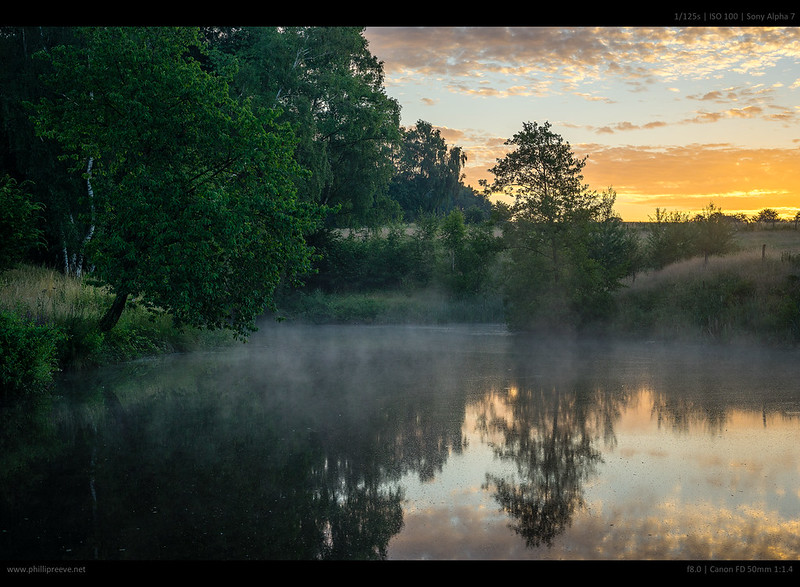
Specifications
| Length | 44mm |
| Diameter | 61mm |
| Weight | 235g |
| Filter Thread | 52mm |
| Aperture Blades | 8 |
| Short focusing distance | 45cm |
The Canon new FD 1.4/50 at ebay.de | ebay.com (affiliate links)
Versions
As far as I know Canon made two mechanically and optically different 1.4/50 FD lenses. There was also an even older FL 1.4/50.
- The older FD S.S.C. version has the classic silver breech lock mounting system and weights 370g and it is larger. Size and weight are the result of a very solid construction.
- The new FD version (nFD in short) is much lighter at 235g and has the new FD mounting system. Built quality is okay but more plasticky. I own this version and this review is about it. Notice that the inscription is still Canon FD, not new FD which is an inofficial name.
I never used the older FD version so I can’t tell you how they compare optically. Comments on the comparison are welcome!
Size, Weight and Handling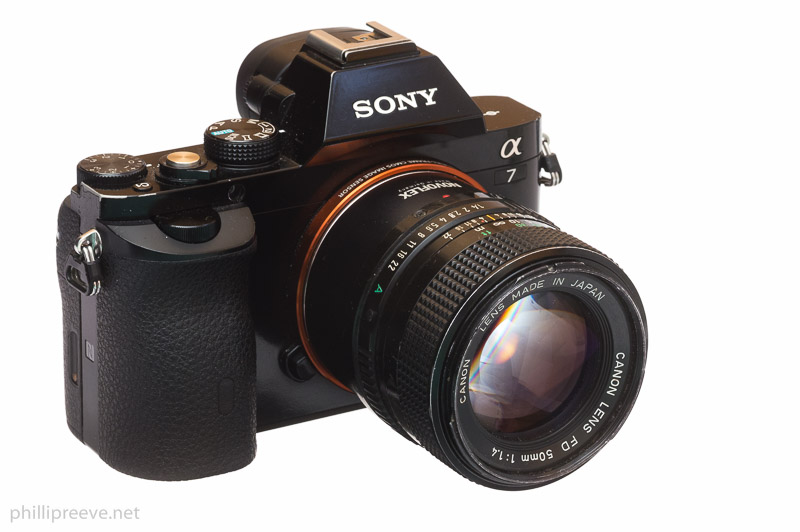
The lens is very well balanced on the a7, because it is relatively small and light.
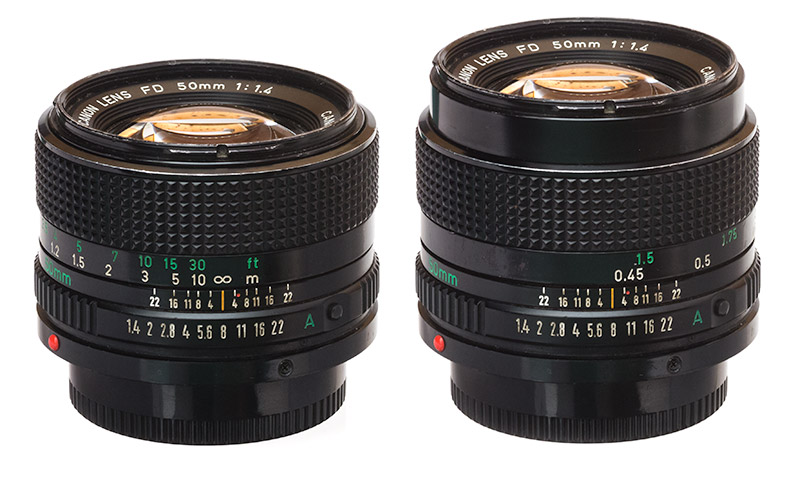
The focusing ring turns about 110° from the short focusing distance of 45cm to 1m and a further 40° to infinity. Focusing is smooth with little resistance.
The aperture ring of the Canon has a higher resistance than I would prefer and the lens stops down in half steps to f/22.
The barrel of the lens is made from metal and some parts like the aperture ring and the plate around the front of the lens are made from plastics. By todays standards this is a rock solid lens but some older lenses feel a bit more solid.
The front ring does not rotate the lens is focused which makes the usage of polarizers easier.
Lens Hood
I don’t own the original lens hood BS-52 but from the pictures I have seen from it it is quite large.
Optical Performance
Flare Resistance
Neither very good nor very bad. Moderate contrast loss and some ghosting.
At f/1.4 you sometimes see a little rainbow like in this image, you can get rid of by using a hood or shielding your lens with your hand
Distortion
A small amount of barrel distortion, only relevant for the most critical applications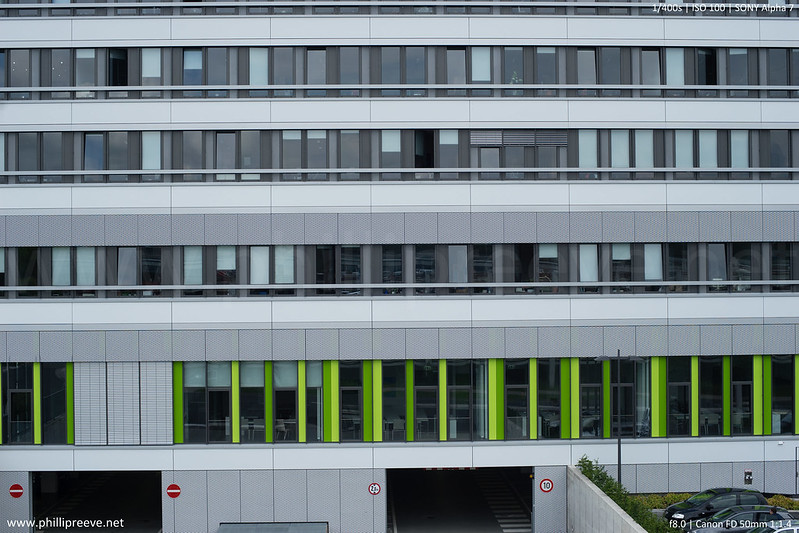
Vignetting
At f/1.4 vignetting is very noticable, at f/2 it is less noticeable but still distracting for a few applications and from f/2.8 there is no vignetting for all practical applications.
Bokeh
Decent but not great. Specular 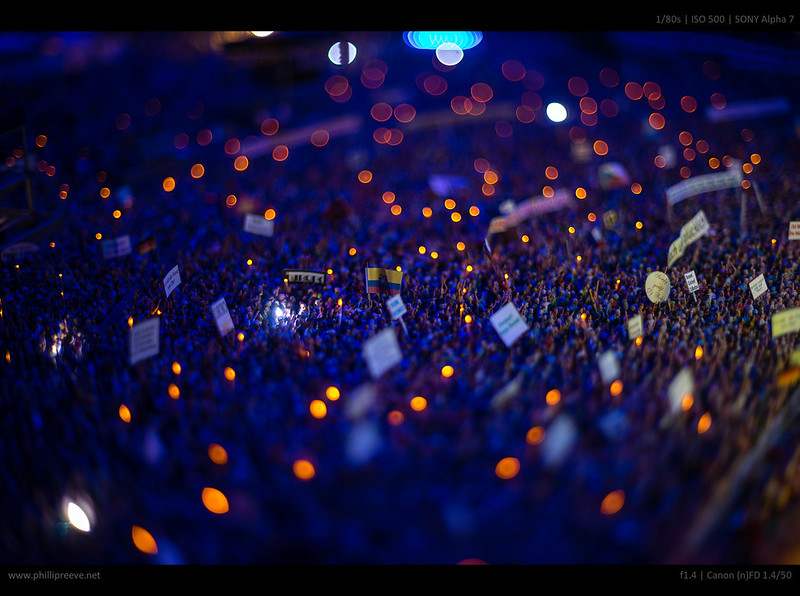
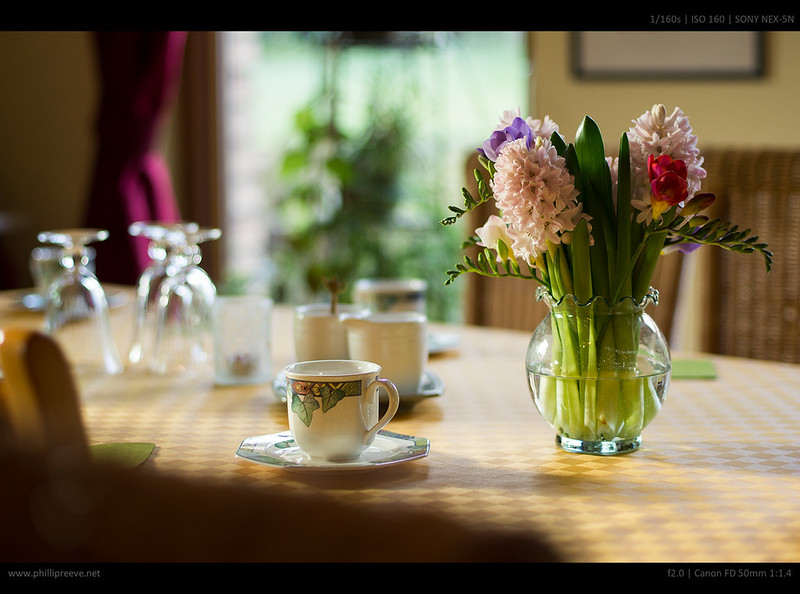

Sharpness

f/1.4: Resolution is quite high in the center and midframe region and very low in the corners. Contrast is lower and micro contrast is very low due to some spherical aberration.
I think the lens performs quite a bit better at shorter distances with more contrast.
f/2: Much more contrast in the center, sharpness is quite high across most of the frame with bad corners.
f/2.8: A little sharper in the center.
f/4: Excellent sharpness across most of the frame, corners start to improve.
f/5.6: Only the last few pixels in the corners are a little blurry, excellennt across the rest of the frame.
f/8: Excellent across the frame.
f/11: A little softer due to diffraction.
I think f/1.4 is very usable for portraits, f/2.8 will give very very good results for almost any application but for critical landscape work with detail in the corners you should stop down to f/8.
Alternatives
Back in the 80s any major manufacturer had a 1.4/50 lens in it’s lineup. These normal lenses share more similarities than differences but every lens has characteristics which sets it apart from it’s peers.
- Minolta MD Rokkor 1.4/50: Not as sharp at f/1.4 and still a little behind at f/2 but it has nicer bokeh in my eyes, the 6 aperture blades are a disadvantage though.
- Minolta MD 2/50: Better for landscapes and architecture, not as good for portraits and available light photography.
- Pentax SMC 1.4/50: Never tried one myself but it has a very good reputation and I guess it could be as good at f/1.4 while having nicer bokeh.
- Zeiss FE 1.8/55: The Zeiss is a lot sharper in the corners and a little sharper in the center at f/1.8, it has nicer bokeh, is more flare resistant and you can buy about 15 Canon nFD 1.4/50 for it’s price.
Conclusion
good
|
average
|
not good
|
I think the biggest strenth of the Canon nFD 1.4/50 is it’s sharpness at f/1.4. It clearly outperforms all the other fast normal lenses I know in this regard. At f/2 it is still better than the competition and the 8 aperture blades are also and advantage.
Stopped down to f/8 it is very very sharp from corner to corner but this can be said about many normal lenses. The lens is also rather small and light for a 50mm lens while it is very affordable and easiliy available.
There are only a few shortcomings. One of them is quite nervous bokeh in the transition zone. This is not an issue for portraits but it can be distracting for pictures of flowers and other stuff at closer distances, other lenses perform better in scuh settings. You also need to stop down quite a bit for good corner performance but this is expected from a fast 50mm lens and the results are very good at f/5.6.
All in all I think the Canon new FD 50mm 1:1.4 is a good and versatile lens which will give very good results in a very wide range of applications. I also think it is the 1.4/50 lens with the best value.
You can buy the Canon new FD 1.4/50 at ebay.de | ebay.com (affiliate links).
If this review was helpful to you, please consider using one of my affiliate links. I will earn a small commission on your purchase and it won’t cost you anything. Thanks!
For the right adapter check out our Adapter Guide.
Sample Images Canon FD 50mm 1:1.4
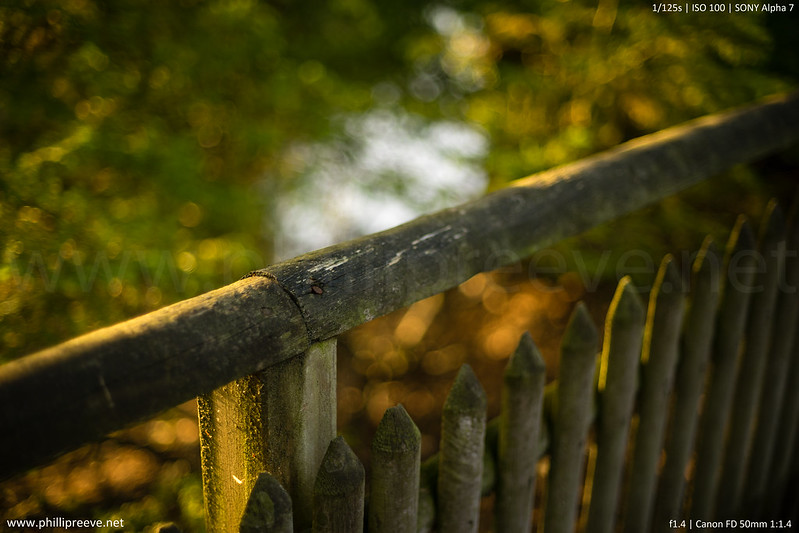

f/8You can find more full resolution images in this flickr set: Canon new FD 50mm 1:1.4 full resolution sample images
Other Articles
- The Guide to Canon FD lenses in the digital age
- An introduction to manual lenses on the a7
- Affordable manual lenses for the Sony Alpha 7,7r,7ii,7rii and 7s
This site contains affiliate links. If you make a purchase using any of the links marked as affiliate links, I may receive a small commission at no additional cost to you. This helps support the creation of future content.
Latest posts by Phillip Reeve (see all)
- Review: Samyang AF 75/1.8 FE - April 12, 2021
- The FE-List now has 113 lenses on it - March 25, 2021
- 2020 – Year’s end review - December 28, 2020
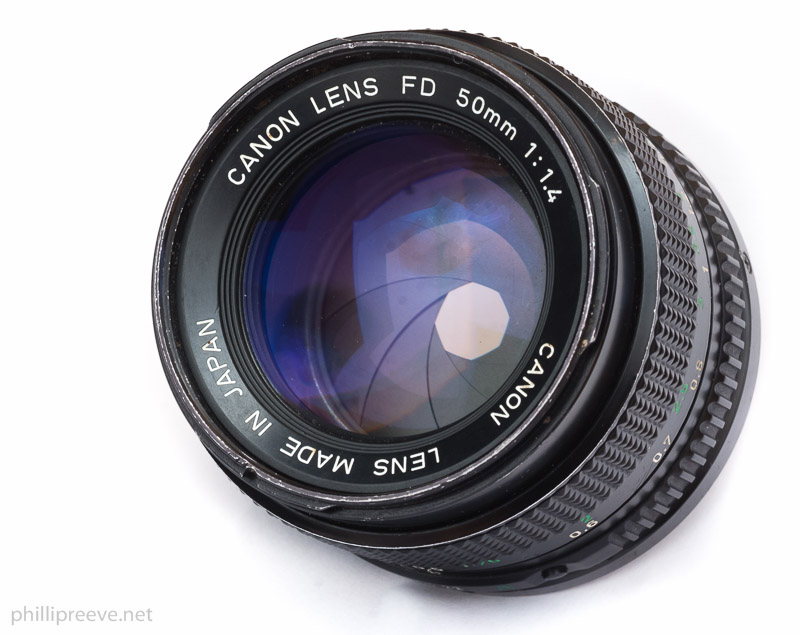


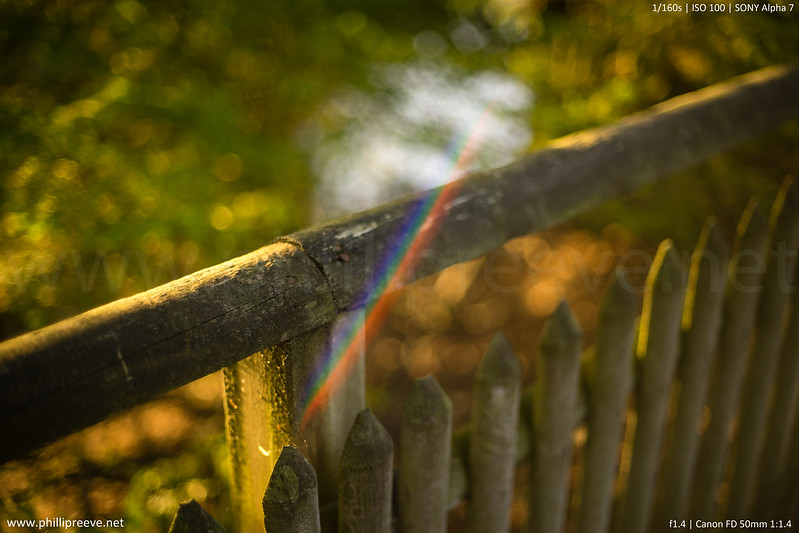
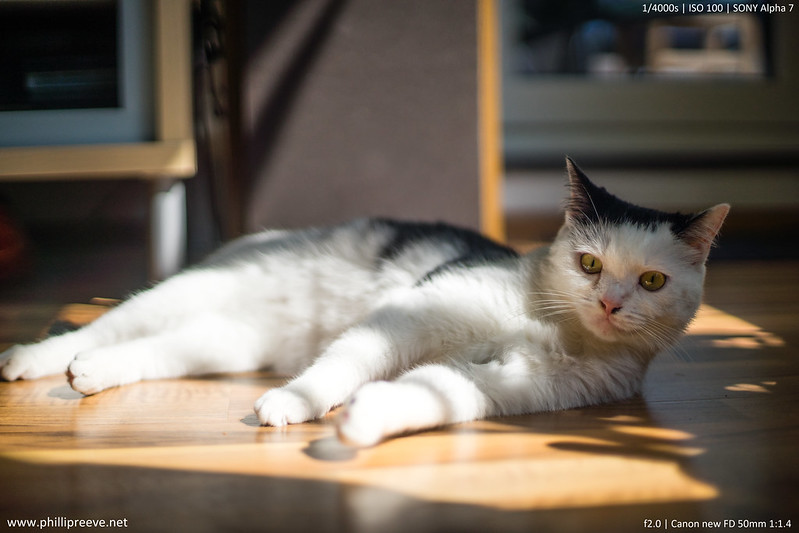
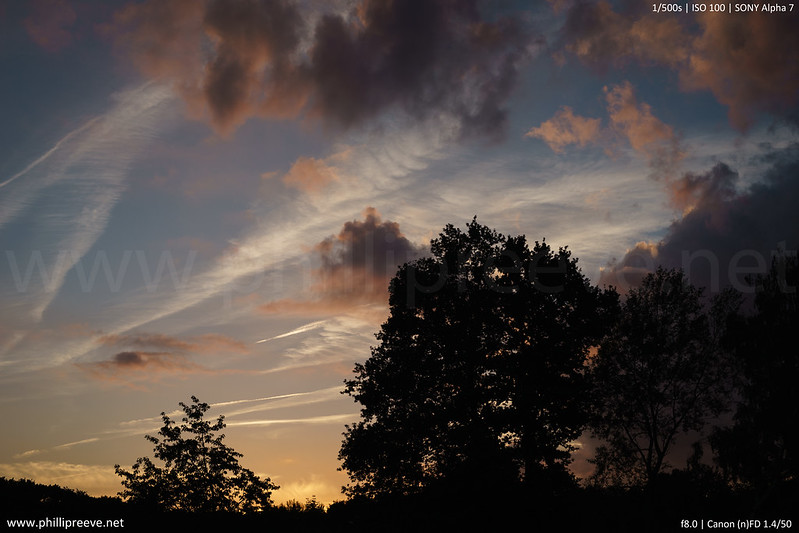
Great review, Phillip! I have one question about this lens. What hood can you recommend to use with?
I don’t have a hood for it, sorry 😉
I have this lens and never take the hood off. Definitely recommend it. Check out KEH for the BS-52 hood
If you use it on APS-C camera you can buy any tele hood with a 52mm thread. On full frame just find a shorter one.
I have my second nFD 50/1.4 and it is just best there after Zeiss. My breech lock version—FD 50/1.4 S.S.C was slightly softer than the new one. My Pentax-M 50/1.4 came very close to it but all others just don’t have the contrast (and sharpness at larger apertures) as this one.
Highly recommended!
Great, just waited for this review 🙂
I wrote a piece on this lens too, comparing it to the Sony Zeiss 55 f1.8 Sonnar and I think we reached the same conclusion: its a stunning optic, especially considering the price. For landscape photographers who won’t miss the lack of AF, its even more compelling.
While the 55mm f1.8 Sonnar has few peers at wider apertures, its amazing how these 30 year old lenses bought for such small sums on ebay can give it a run for its money at the sort of apertures most people use for scenic photography.
FWIW the 35mm f2 and f2.8 lenses are equally astonishing. I tested the 35mm f2.8 and found it exceeded the performance of my 35mm Zeiss Sonnar at f8, at the edges.
then I am looking forward to test the nFD 2.8/35. I have a copy sitting in my lens cabinet.
How would you compare this the the Minolta 50mm 1.7?
I think the Canon is quite abit better
MD 50/1.7 is a decent one. I have it.
A bit better would be Auto Chinon MC 50/1.7 or Yashica ML 50/1.9 (or 2.0). Also Rokinon XR 50/2 S is sharper than Minolta even though its contrast is quite low. Needs post processing.
nFD 50/1.4 is just better than these ones except perhaps for Bokeh. If you get your hands on Pentax-M 50/1.4 you’ll have a beautiful bokeh and great sharpness. Its contrast is also almost as good as that of nFD.
Cheers!
Thanks for the advice! Where can I get a proper adapter for the Pentax-M 50/1.4?
there you go 🙂
Auto chinon 50/1.7 or 55/1.7? Mine is 55, dont know 50 exist
Schöne Besprechung und Du hast sicher Recht, wenn Du manchmal schreibst, dass das Adaptieren von Altglas an Vollformat mehr Spaß macht als an Cropformaten.
Frage: Du empfiehlst das Pentax SMC 50/1.4, weil es ein besonders schönes Bokeh haben soll. Meinst Du damit das K-Objektiv von 1975?
Hallo Karen, um das nach zu gucken bräuchte ich ordentliches Internet. Bin aber gerade in den Alpen 🙂
Grüße,
Phillip
Dann schöne Tage in den Alpen! Bin gespannt auf die Fotos 🙂
Ich habe mir das Canon nFD 50/1.4 für meine MFT Kamera geholt wo es ein sehr schönes Telephoto Objektiv abgibt. Die Vorteile an der Nutzung mit Crop ist, dass man die unscharfen Ecken nicht im Bild hat. So habe ich bereits bei f/1.4 ein gutes Bild (auch in den Ecken) und bereits ab f/2.8 ist mit meiner 16MP Lumix G7 kein deutlicher Schärfeunterschied mehr zu f/5.6 zu erkennen. Ich würde also nicht sagen dass man solche Objektive besser mit Vollformat Kameras nutzt, denn der Crop kann einige schlechte Charakteristiken verbergen.
Hallo Phillip, zum Testbild rechts neben “Sharpness” (der link zu flickr funktioniert anscheinend nicht, man kann es jedoch dort direkt aufrufen und betrachten):
die crop-Bereiche für das Zentrum bzw. dito etwas außerhalb befinden sich im Motiv in signifikant unterschiedlicher Raumtiefe zum Bereich der Ecke (bzw. unterschiedlicher Entfernung zum Bildfeld). In Deinem Bemühen, in sämtlichen Bereichen anscheinend gleichzeitig die maximale Auflösung darzustellen, liegt die Vermutung nahe, dass Du Bereiche mit unterschiedlichen Objektdistanzen individuell fokussierst und die Crops daher keine Beurteilung der Bildfeldwölbung der Optik ermöglichen. Ein Fehler wäre (Konjunktiv) das nicht, lediglich eine spezielle Möglichkeit der Methodik, die jedoch leider unerwähnt bleibt. Oder kann man irgend wo etwas zu Deiner jeweiligen (oder immer gleichen…) Vorgehensweise lesen?
Güße
Die alte Testreihe die bei flickr liegt war in der Hinsicht tatsächlich problematisch, dort habe ich nicht nachfokussiert und das Motiv hatte eine zu große Tiefe. Die Testreihe auf der meine Analyse beruht und deren Verlinkung schief gegangen ist, ist aber eine andere. Motiv ist dort eine zur Kamera orthogonale Bergkette in mehreren Kilometern Entfernung.
Ich habe die richtige Reihe jetzt bei flickr hochgeladen. Leider kann ichs wegen technischen Problemen aber gerade nicht im blog richtig verlinken. Auf jeden Fall danke für den Hinweis, wird gefixt sobald möglich.
Thanks for this review man!
Hello,
Nice review. I have this lens (ssc version) and have testet it out with good results.
I also have a Minolta MD 50mm f1.2. Du you know what adapter I can use with this lens on the Sony A7rII camera? The Fotodiox did not work, dont fit on the camera..
Thanks!
For the adapter I would check out amazon and read the reviews carefully. If an adapter doesn’t fit on the a7ii people will mention it.
Hallo Philipp,
Wie siehst du die Schärfe im Vergleich zu dem Minolta Md Rokkor PG 50mm 1.4?
Grüße
MaKe
bei Offenblende ist definitiv das Canon besser, bei f/2 hat es wahrscheinlich auch noch einen leichten Vorsprung
between minolta 50mm f1.4 and canon fd 50mm f1.4 wich has better bokeh?
Minolta
i bought it today with sony a6000,and your photos are so sharp,mine are not sharp
when i zoom at 100% it’s totally garbage,my sigma 30mm f2.8 is so sharper than this lens
this is normal?
and i tested again with raw files and now canon is sharper
i’m confused
in f 1.4 it’s so soft,but in f 2.8 is so sharp,in all of these lenses that you tested before wich one was sharper in wide open? thank you
none. The Canon is one of the sharpest classic 50mm lenses. I think the FD 1.2/55 Aspherical and FD 1.2/50 are sharper at f/1.4 but I never tested them. Today the Sigma Art 1.4/50 is your best bet if you want very good performance at f/1.4
thanks for your answer,samyang 85 mm f1.4 is sharp at f1.4?
yeah, sharper than the Canon but a totally different focal length
I recently sold off a few FD wide angle primes and replaced them with the EF 17-40… but even with the 50 1.8 STM in my arsenal I couldn’t bring myself to put the 50 1.4 FD on the auction block. 1 because I wouldn’t get anything for it, and 2 because it’s so much fun to shoot with. Snick, snick goes the aperture ring. I can feel the perfectly weighted and scaled focus ring. Output is not bad either aside from the nervous bokeh though I found it to be too soft wide open. I don’t open up more than F/2.
Hello! You mentioned ‘new FD mount’. Do I need any special adapter for NEX or regular Nex to Canon FD adapter will work just fine?
Thanks!
The regular adapter will work fine.
Hello. Compare Canon nFD 50 1.4 to Sony FE 50 1.8, which one has better image quality in your opinion? (Both uesd on A7) Many thanks!
The Canon is sharper, the Sony has smoother bokeh wide open and more contrast.
Today I tested some of my FD and FL (the older FD with a ring to attach and indeed somewhat heavier) lenses with adapter on a Fuji X-E1 and I was stunned by the sharpeness of the FD 50mm F1.4. So I googled on it and found your review. I tested the FL 85mm F1.8, sharp but not that stunning effect the 50mm had on me. It is not a Sigma 50 mm F1.4 Art (on a FF canon 6D), but for such an old lens and on a older Fuji X-E1, really amazing. Thanks for your review, very nice to share those experiences.
How about the Nikkor 50 lenses? Can Canon FD 50 1.4 compare with them?
The Canon ist sharper
Hallo Philipp, wirklich eine tolle Sammlung von Reviews! Ein Vergleich von 50mm Objektiven hab ich aber noch nicht gefunden, ist eins geplant? Ich hab eine Sony A6000 und will mir eine Festbrennweite zulegen. Meine Frage ist: Habt ihr Erfahrungen wie dieses Retro Objektive im Vergleich zu den modernen wie dem Sony 50mm 1.8 OSS, der Sigma Art 2.8 und dem Sigma 50mm 1.4 abschneiden? (jetzt mal unabhängig von AF und OSS)
Erstmal ist da nichts geplant. Aber vielleicht hilft mein Review des 1.8/50 OSS weiter?
Ja, das beantwortet die meisten Fragen, danke!
Hallo Johann!
ich hab eine A6300 mit Novoflex Adapter wo ein FD 50mm/1.4 S.S.C drauf ist. Kann mich dem Review vom Phillip nur anschließen… extrem geiles Objektiv und dank Crop-Faktor noch “besser”. Anbei ein paar Fotos:
https://www.instagram.com/p/BaS4LeaAOcr/?taken-by=danielkissler
https://www.instagram.com/p/BaRIkCEAz24/?taken-by=danielkissler
https://www.instagram.com/p/BaVp3vnAoOw/?taken-by=danielkissler
lg
Do you know how this lens performs when it comes to coma? If so, does it fare better or worse than the Minolta 1.4? I’m asking in regards of night and astro shots.
both are not great for astro
Very impressive blog. Really a lot of data.
I can buy only one adapter for my sony a7sII. Should I go for minolta or canon fd lens?
Thanks
Canons are a tad sharper, Minoltas have nicer colors and better build quality.
Thanks a lot for taking your time to answer. I will get everything I can through your affiliate links.
Thanks for the support, it is appreciated 🙂
HI Phillip, Your website is amazing. Thank you for the world of info you provide. I have a Zenitar 50mm 1.7 that I use on my A7II, the lens is sharp but has quite a low contrast, I wonder if you had a chance to compare the Canon FD with the Zenitar?
No experience with the Zenitar, sorry.
Is this the same lens?
https://www.keh.com/shop/canon-50mm-f-1-4-bl-fd-mount-lens-55-canon-50mm-f-1-4-bl-fd-mount-lens-55.html
No, it is the predecessor.
Thank you. And thank you for this awesome collection of goodies.
I think I found the right one?
https://www.keh.com/shop/canon-50mm-f-1-4-fd-mount-lens-52-canon-50mm-f-1-4-fd-mount-lens-52.html
Would you recommend the Fotodiox Lens Mount Adapter?
https://fotodioxpro.com/products/fd-snye
that’s the one
thanks for the fine review
You are welcome 🙂
I came here to discover your view, your take on this dessert called a Canon FDn 50 1.4
That’s what it is you know? A flavor, a taste, something unique to itself…
How other people view these tasty treats as scientifically measured only, void of all aroma and flavor …
I can only imagine
thanks, for your insight into this lens
Hello,
This article was written in 2015, so I am asking if you think now ( maybe you tested Pentax SMC 1.4/50) that the pentax is at least as good as the canon fd 50mm 1.4 performance wise? You said the bokeh is nicer..what about sharpness,comma etc? Would you buy the pentax over the canon?
The prize range is pretty much the same.
Really nice and helpful reviews!!
Regards
Still haven’t used the Pentax 🙂
Hey man, it’s been 2 years almost.
I’m in the same dillema currently, which one did you go with? Is the Pentax better?
cant open the sharpness image in this article, on flickr it starts @f2
found it
https://www.flickr.com/photos/96189377@N08/21728431498/in/album-72157648508801988/
Hello to all you great fans
I would like to share my personal conclusions.
I tested 3 50mm lenses.
1. Minolta 58mm 1.4 mc
2. Canon new fd 58mm 1.4
3. Nikon pancake 50mm 1.8
The Canon beat all in sharpness and contrast.
The minolta had the smoothest bokeh and was as sharp as the Canon from 2.8 to f/8 with less contrast than the Canon.
The Nikon to my surprise was the worst at 1.8. When at f/4 – f16 it is as contrasty as the Canon but with less micro detail.
All 3 lens copies are 99% new mint, shot on a Fuji X-T1.
The best build with no question is the MC ROKKOR 58MM 1.4…All metal. The others feel amateur in comparison.
Without any doubt this is a helpfull test. I understand that lenses with fast apertures are tested under digital aspects like portraits. But one should not forget that analogue lenses have their optimum beginning at 100 times of their focal lens. For 50mm lenses this are 5 meters.
Your statement is correct in most cases and probably in this one as well but certainly not for any analogue lens. One case where it was very obvious is the Olympus OM 3.5/50 macro which is much better at 1:10 than at infinity or 1:2.
Hi Phillip, I’ve been enjoying your articles a lot. Did you ever get a chance to review of the LTM Canon 50mm 1.4? I’d be very curious to hear if there’s an image quality difference between the FD and the LTM. The LTM is noticeably more expensive (two to three times). A more compact package is certainly worth something to me, but an increase in image quality would better justify the purchase. Is it just Leica price inflation though? There are reviews online by other reviewers of the LTM but they don’t do as good a job as you.
Thanks for all your hard work!
T
Wanted to review for some time but never got a good opportunity to buy one and at the moment I find little time for reviews. Sorry 🙂
Dude, that shot of the crowd is rad.
Hey there and thanks for a typically useful and insightful look at the Canon FD 50mm.
As this review was published some time ago you may not be so interested in hearing my experience of my silver ‘breech-look’ SSC version but I just wanted to tell you, and I suppose see if many others have had the same experience of it as me.
My copy seems very clean and hasn’t had any obvious damage so having read your other article on checking de-centered lenses I wonder if that is the case with mine.
As in the middle of my example, the lens is indeed sharp as long as it is not an overly bright and contrasty scene as the lens is terribly glowey at f1.4.
But stopping down to f2 and beyond eliminates the glow nicely and the centre becomes ferociously sharp.
However, it is the areas beyond the centre area that are mushy even beyond f8.
As I say, I don’t know if that is just my copy or if it’s typical but I’ll happy send you through some screen grabs that demonstrate the issue if it is of any interest.
Regards and thanks for all you do. Great site!
Hen
does anything “jingle” when you shake your lens ?
Happened to me once, an element was not tightened enough -inside-. Images were soft as well in some regions (1 or 2 corners out of 4, depending on how i angled the lens).
Can’t remember what lens it was….
Nice review! Between Minolta 50mm f2 and this one wich would you think is better regarding sharpness, but mostly colours and contrast? I’m not sure I need 1.4 often but more modern look regarding contrast and colour might be more decisive.
phew. I think I would chose the Minolta or a Zeiss C/Y 1.7/50.
Sold mine like 10 years ago when I stopped analog. Always regretted it….
I remembered it was so easy to focus and lightweight at the same time. GAH so good !
I decided to buy it back with my new/used Sony A7.
I still have a Jupiter 3 (50/1.5) but focus throw is kinda long and not so easy to manipulate/action ready. It’s reserved for “dreamy shots” lets call it.
And then there’s my Helios 44-2 (58/2) that I use as my “cheapo” lens for parties with friends. Focus is easy and the swirly bokeh always pleases everyone 😀
Skin colors are great with this lens. But its strong point is video.
Hello.
You write: “The focusing ring turns about 110° from the short focusing distance of 45cm to 1m and a further 40° to infinity.”
But in the pictures of the lens it really looks like the focusing ring turns about 90° from 1m to infinity, not 40°.. Am I missing something here?